COMMENT OF THE DAY: BOSTON. IT’S WORTH IT TOO. 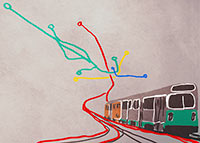 “I live in Boston which is pretty much the anti-Houston, moving there as an adult fleeing some of the things Blue Dog celebrates. Born and raised in sprawling Omaha, Nebraska, with its struggling downtown and leapfrogging subdivisions, I came east seeking the density, the option of subways and streetcars and walking because of the relative proximity of destinations, the historic architecture of row houses and institutions, the amenities of a major gateway city with an urban vibe. You’d hate Boston, the high cost of living, the terrible traffic on our chaotic layout of colliding streets, the lack of space, and the cold winters. I don’t like those things either, but I’ve decided to live with them because of the things I do like. You’ve made your choice too, and you intelligently don’t deny that you live in flat, sprawling, hot-humid, ten-lane-wide highway beribboned mass of strip mall scattered anonymity because you like it. And no snobby eastern elitist transplant so blinkered, he can’t appreciate the collective expression of American freedom that is Post Oak or The Woodlands or Sugarland or cul-de-sac-paradise-of-your-choice will . . . convince you otherwise. Midtown does seem to me kind of nice though :-)” [Robert H, commenting on Comment of the Day: The Real Houston Is Outside Those Tiny Urban Islands] Illustration: Lulu
“I live in Boston which is pretty much the anti-Houston, moving there as an adult fleeing some of the things Blue Dog celebrates. Born and raised in sprawling Omaha, Nebraska, with its struggling downtown and leapfrogging subdivisions, I came east seeking the density, the option of subways and streetcars and walking because of the relative proximity of destinations, the historic architecture of row houses and institutions, the amenities of a major gateway city with an urban vibe. You’d hate Boston, the high cost of living, the terrible traffic on our chaotic layout of colliding streets, the lack of space, and the cold winters. I don’t like those things either, but I’ve decided to live with them because of the things I do like. You’ve made your choice too, and you intelligently don’t deny that you live in flat, sprawling, hot-humid, ten-lane-wide highway beribboned mass of strip mall scattered anonymity because you like it. And no snobby eastern elitist transplant so blinkered, he can’t appreciate the collective expression of American freedom that is Post Oak or The Woodlands or Sugarland or cul-de-sac-paradise-of-your-choice will . . . convince you otherwise. Midtown does seem to me kind of nice though :-)” [Robert H, commenting on Comment of the Day: The Real Houston Is Outside Those Tiny Urban Islands] Illustration: Lulu
Tag: Sprawl
COMMENT OF THE DAY: TURNING HOUSTON INSIDE OUT 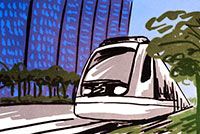 “It might be that the best outcome for Houston is for the Inner Loop to have an exurban quality of life. Send commuter rail out to the suburbs — not for the suburbanites to commute to downtown — but for the Inner Loopers to commute outbound in the mornings to densely clustered (out of necessity) suburban tall office towers surrounding the stations, and then back into town in the evenings.
This is more viable than the traditional idea of New Urbanist suburbs with transit connecting them to a downtown core since politically none of Houston’s suburbs are on board with cultivating a small town ambience, but are ok with letting office builders do their thing.
To be sure, suburbanites would still commute to downtown but it will be seen as an aberration. Downtown will still have things to do after dark, but other areas of the Inner Loop, connected by LRT/buses/cars/bikes/sidewalks, will do a much better job of providing the QOL aspiring exurbanites may crave.
Suburbanites will, of course, still commute to a large extent to the office towers in their suburb. But they will do so by car, and won’t care about the urbanist quality of life (in other words, nothing will change for them).” [anon22, commenting on Here’s the Freshest Satellite Photo of Downtown Houston You’ll See All Day] Illustration: Lulu
“It might be that the best outcome for Houston is for the Inner Loop to have an exurban quality of life. Send commuter rail out to the suburbs — not for the suburbanites to commute to downtown — but for the Inner Loopers to commute outbound in the mornings to densely clustered (out of necessity) suburban tall office towers surrounding the stations, and then back into town in the evenings.
This is more viable than the traditional idea of New Urbanist suburbs with transit connecting them to a downtown core since politically none of Houston’s suburbs are on board with cultivating a small town ambience, but are ok with letting office builders do their thing.
To be sure, suburbanites would still commute to downtown but it will be seen as an aberration. Downtown will still have things to do after dark, but other areas of the Inner Loop, connected by LRT/buses/cars/bikes/sidewalks, will do a much better job of providing the QOL aspiring exurbanites may crave.
Suburbanites will, of course, still commute to a large extent to the office towers in their suburb. But they will do so by car, and won’t care about the urbanist quality of life (in other words, nothing will change for them).” [anon22, commenting on Here’s the Freshest Satellite Photo of Downtown Houston You’ll See All Day] Illustration: Lulu
COMMENT OF THE DAY: THE REAL HOUSTON IS OUTSIDE THOSE TINY URBAN ISLANDS 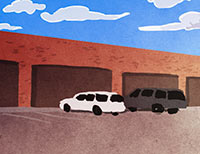 “Urban enthusiasts live in a bubble. I don’t care where they are. The reality is that the VAST majority of people like getting in a private air conditioned car, driving to an island of shopping or whatever and finding a parking space closest to where they are going without being bothered by street people. Urban enthusiasts are under the delusion that most people want to walk around in sticky moist air and sit at their desk stinking all day from sweat in order to pretend they live in a city that was built before cars were invented so they can live like the people they envy on t.v.
A dense urban environment in the inner city would be a novelty and I’m all for it. Choices are great. Downtown and Midtown are shaping up nicely. The center of Midtown is going to have a very cool buzz going on with all the new infill. The Match, Superblock, Mid-Main development, etc. East side Downtown is going to be a beast and so will Market Square.
But as cool as it may be to have a tiny, tiny, microscopic sliver of New York in the center of this city, it is totally unnecessary. Our booms have proven that. The VAST majority don’t have a problem with strip malls, blue glass or driving cars to get where they want to go. The VAST majority stay in Houston because they WANT to live in a suburban environment. Jobs? There are jobs in other cities. No one stays in Houston long if they really hate it. You can’t argue with success. Builders keep building things the way they do in Houston because it works.
‘Quality’ is subjective. Some people think Miley Cyrus is quality. But you can’t argue with ‘quantity.’ Houston is fascinating to people (even the haters) because whatever it is, unlike many of those true centers of urbanity on the east and west coast, Houston IS NOT stagnant. Even in slower economic times, things happen in Houston and it is fun watching it grow.” [Blue Dog, commenting on Comment of the Day: Still Waiting To See How Houston Is Going To Turn Out] Illustration: Lulu
“Urban enthusiasts live in a bubble. I don’t care where they are. The reality is that the VAST majority of people like getting in a private air conditioned car, driving to an island of shopping or whatever and finding a parking space closest to where they are going without being bothered by street people. Urban enthusiasts are under the delusion that most people want to walk around in sticky moist air and sit at their desk stinking all day from sweat in order to pretend they live in a city that was built before cars were invented so they can live like the people they envy on t.v.
A dense urban environment in the inner city would be a novelty and I’m all for it. Choices are great. Downtown and Midtown are shaping up nicely. The center of Midtown is going to have a very cool buzz going on with all the new infill. The Match, Superblock, Mid-Main development, etc. East side Downtown is going to be a beast and so will Market Square.
But as cool as it may be to have a tiny, tiny, microscopic sliver of New York in the center of this city, it is totally unnecessary. Our booms have proven that. The VAST majority don’t have a problem with strip malls, blue glass or driving cars to get where they want to go. The VAST majority stay in Houston because they WANT to live in a suburban environment. Jobs? There are jobs in other cities. No one stays in Houston long if they really hate it. You can’t argue with success. Builders keep building things the way they do in Houston because it works.
‘Quality’ is subjective. Some people think Miley Cyrus is quality. But you can’t argue with ‘quantity.’ Houston is fascinating to people (even the haters) because whatever it is, unlike many of those true centers of urbanity on the east and west coast, Houston IS NOT stagnant. Even in slower economic times, things happen in Houston and it is fun watching it grow.” [Blue Dog, commenting on Comment of the Day: Still Waiting To See How Houston Is Going To Turn Out] Illustration: Lulu
HOUSTON DEVELOPMENT ANALOGIES YOU CAN EAT FOR BREAKFAST  Here’s a freshly baked city-development paradigm that’s a pretty good, but imperfect match for Houston, writes Christopher Andrews: “Houston’s inner core, at least that area within the I-610 loop, predominantly west of I-45, makes up most of the ‘new donut’ downtown area, even though Houston’s currently gentrifying and historically vibrant neighborhoods lie just outside of its downtown district. Our ‘Inner Suburbs and Inner Core’ portion of Houston (think Alief, Sharpstown, Southwest and Southeast Houston, Northside, Acres Homes) is continuing to age, and is evidenced when we look at home sale prices. Naturally, then the newer homes in the ‘Collar Counties’ (think Sugarland, Cinco Ranch, The Woodlands, Kingwood) attract families and professionals looking for new housing. That comprises Houston’s ‘new donut’ paradigm.” Why stop there? There are scone and English muffin models to consider too. But which breakfast item best describes the shape of the city? “While I love donuts, I like bagels too,” Andrews writes. “Houston’s development, and the downtown development in many cities, is more like the experience of having a cinnamon crunch bagel at Panera, which one can argue is much like a donut anyways. You know the bagel has a hole in it somewhere. It’s just filled in with sweet, cinnamon-y toasted sugar. You know the hole is there in the middle of the doughy periphery, it’s just filled in. Maybe that toasted cinnamon sugar filling is the gigantic amount of sweet public funding that cities have dedicated to building these stadiums, convention centers, and even residential developments.” [Not of It] Photo of Cinnamon Crunch Bagel: Panera
Here’s a freshly baked city-development paradigm that’s a pretty good, but imperfect match for Houston, writes Christopher Andrews: “Houston’s inner core, at least that area within the I-610 loop, predominantly west of I-45, makes up most of the ‘new donut’ downtown area, even though Houston’s currently gentrifying and historically vibrant neighborhoods lie just outside of its downtown district. Our ‘Inner Suburbs and Inner Core’ portion of Houston (think Alief, Sharpstown, Southwest and Southeast Houston, Northside, Acres Homes) is continuing to age, and is evidenced when we look at home sale prices. Naturally, then the newer homes in the ‘Collar Counties’ (think Sugarland, Cinco Ranch, The Woodlands, Kingwood) attract families and professionals looking for new housing. That comprises Houston’s ‘new donut’ paradigm.” Why stop there? There are scone and English muffin models to consider too. But which breakfast item best describes the shape of the city? “While I love donuts, I like bagels too,” Andrews writes. “Houston’s development, and the downtown development in many cities, is more like the experience of having a cinnamon crunch bagel at Panera, which one can argue is much like a donut anyways. You know the bagel has a hole in it somewhere. It’s just filled in with sweet, cinnamon-y toasted sugar. You know the hole is there in the middle of the doughy periphery, it’s just filled in. Maybe that toasted cinnamon sugar filling is the gigantic amount of sweet public funding that cities have dedicated to building these stadiums, convention centers, and even residential developments.” [Not of It] Photo of Cinnamon Crunch Bagel: Panera
HOW LIBERTARIANS DESCRIBE HOUSTON, PLAYING THE NEW YORK CARD, AND THE SUE ELLEN MISCHKE OF METROPOLISES 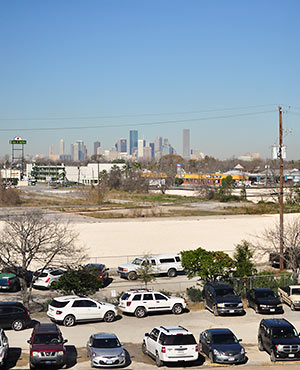 Cort McMurray stuffs more colorful Houston-in-a-phrase quips into his latest in-search-of-the-city essay than will fit in this little lookie-here linkpost, but a few are worth drawing out: “There is a wide difference of opinion on whether [Houston’s] messiness is a good thing. Some of us find it distressing. Tory Gattis and the other evangelists of ‘Opportunity Urbanism’ disagree, painting Houston as a sort of libertarian paradise, a place where fully actualized men and woman can work out their destinies through grit, brains, and good ol’ trial and error. Master plan? We don’t need no stinking master plan.
Surveys indicate that the majority of Houstonians are quite content to live in this Sue Ellen Mischke of metropolises: we love ‘the whole free-swinging, freewheeling attitude’ of the place, a city that offers us the strange comfort of knowing that no matter our neighborhood, we’re never more than 37 seconds away from a gas station, a Taco Bell, or an all-night tattoo parlor.
Eventually, all the world will be Houston, endless rings of toll roads forming concentric circles around some increasingly distant downtown, endless vistas of cars and Costcos and ‘lifestyle environments,’ worlds without end. This sprawl is ‘vibrant,’ and suburban ‘opportunity zones’ (opportunity is a key word for these people) are the inevitable result of vibrant, opportunistic people searching for better schools, better shopping environments, and better quality of life. In the Opportunity Urbanists’ perfect world, the Houston exurbs would stretch from the Sabine River to somewhere around Fort Stockton, and any suggestion otherwise amounts to a betrayal, a ‘de-Houstonizing’ of Our Fair City.” Another, more realist vision of Houston from McMurray’s grab bag: a spread-out, risk-graded, need-more-freeways array of poors-filled “gray zones” and haves-filled “safe zones.” [Houstonia] Photo: Candace Garcia
Cort McMurray stuffs more colorful Houston-in-a-phrase quips into his latest in-search-of-the-city essay than will fit in this little lookie-here linkpost, but a few are worth drawing out: “There is a wide difference of opinion on whether [Houston’s] messiness is a good thing. Some of us find it distressing. Tory Gattis and the other evangelists of ‘Opportunity Urbanism’ disagree, painting Houston as a sort of libertarian paradise, a place where fully actualized men and woman can work out their destinies through grit, brains, and good ol’ trial and error. Master plan? We don’t need no stinking master plan.
Surveys indicate that the majority of Houstonians are quite content to live in this Sue Ellen Mischke of metropolises: we love ‘the whole free-swinging, freewheeling attitude’ of the place, a city that offers us the strange comfort of knowing that no matter our neighborhood, we’re never more than 37 seconds away from a gas station, a Taco Bell, or an all-night tattoo parlor.
Eventually, all the world will be Houston, endless rings of toll roads forming concentric circles around some increasingly distant downtown, endless vistas of cars and Costcos and ‘lifestyle environments,’ worlds without end. This sprawl is ‘vibrant,’ and suburban ‘opportunity zones’ (opportunity is a key word for these people) are the inevitable result of vibrant, opportunistic people searching for better schools, better shopping environments, and better quality of life. In the Opportunity Urbanists’ perfect world, the Houston exurbs would stretch from the Sabine River to somewhere around Fort Stockton, and any suggestion otherwise amounts to a betrayal, a ‘de-Houstonizing’ of Our Fair City.” Another, more realist vision of Houston from McMurray’s grab bag: a spread-out, risk-graded, need-more-freeways array of poors-filled “gray zones” and haves-filled “safe zones.” [Houstonia] Photo: Candace Garcia
CALL HOUSTON A METROPOLIS INSIDE THE LOOP, BUT IT’S A MEGALOPOLIS BEYOND 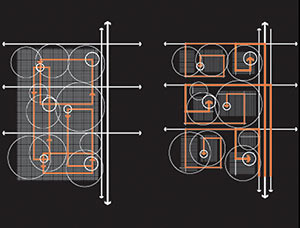 “In the 1950s just about the entire world abandoned continuous block and street urbanism and switched over to spine-based urbanism. We moved from a metropolitan to a megalopolitan type of urbanism and to really get that you have to know the distinction between the two terms. On some level, we all know that when we go outside the Loop that we have moved into a different world, a different reality. The way we navigate outside the Loop is totally different from the way we navigate inside the Loop. Our relationship to nature is different, and our relationship to built form completely changes. We need to be more precise with language in order to appreciate these differences.” — Rice architecture prof Albert Pope, in the latest issue of Cite magazine. [OffCite] Diagram of traffic patterns in grid (left) and spine systems (right): Albert Pope
“In the 1950s just about the entire world abandoned continuous block and street urbanism and switched over to spine-based urbanism. We moved from a metropolitan to a megalopolitan type of urbanism and to really get that you have to know the distinction between the two terms. On some level, we all know that when we go outside the Loop that we have moved into a different world, a different reality. The way we navigate outside the Loop is totally different from the way we navigate inside the Loop. Our relationship to nature is different, and our relationship to built form completely changes. We need to be more precise with language in order to appreciate these differences.” — Rice architecture prof Albert Pope, in the latest issue of Cite magazine. [OffCite] Diagram of traffic patterns in grid (left) and spine systems (right): Albert Pope
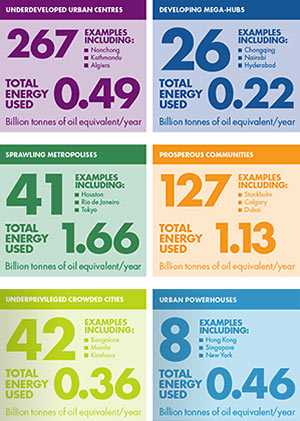 The folks at Shell may not have known a new campaign was about to kick off declaring Houston to be “The City of No Limits,” but a new report from the oil company on the future of cities around the world certainly helps reinforce a just-as-proud image of our 8,778-square-mile Texas spread. “New Lenses on Future Cities,” one of a series of just-released “scenario” studies sponsored by Shell in conjunction with The Centre for Liveable Cities in Singapore, classifies urban areas around the world into 6 distinct categories based on common features.
The folks at Shell may not have known a new campaign was about to kick off declaring Houston to be “The City of No Limits,” but a new report from the oil company on the future of cities around the world certainly helps reinforce a just-as-proud image of our 8,778-square-mile Texas spread. “New Lenses on Future Cities,” one of a series of just-released “scenario” studies sponsored by Shell in conjunction with The Centre for Liveable Cities in Singapore, classifies urban areas around the world into 6 distinct categories based on common features.
Houston, according to the researchers, is too large to be considered one of the Prosperous Communities, and hasn’t earned its way into the Developing Mega-Hubs or Urban Powerhouses clubs. (It certainly doesn’t qualify as an Underprivileged Crowded City or Underdeveloped Urban Centre either) Instead, the report says Houston is a seminal example of a Sprawling Metropolis, proudly featuring it on some accompanying infographics illustrating the archetype (see the green square above). (Other members of this distinctive group of 41 cities include Rio de Janeiro, Tokyo, and Los Angeles.)
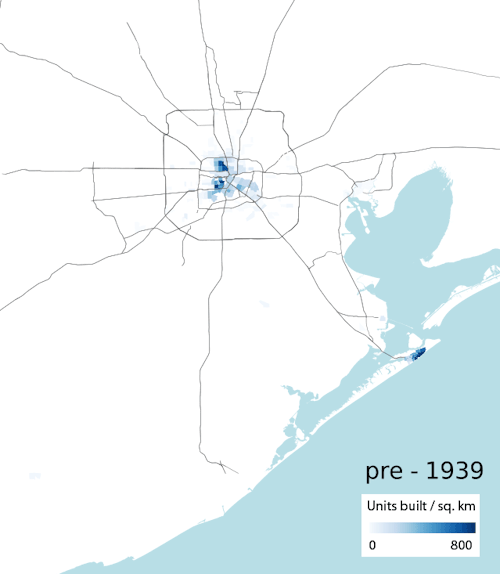
If the Greater Houston Partnership is eager to include some exhibits or animated GIFs to go along with the video footage of cars driving through imaginary barriers, shiny skyscrapers, and smiling people that pepper its new campaign celebrating Houston as The City of No Limits, it might want to look at the work of California computational biologist [and former Houstonian and longtime Swamplot reader] Ian Rees. Using data from the American Community Survey, Rees mapped structures in the region by the decade they were built, grading their concentration with varying shades of blue.  The result helps us visualize the decades-long march of Houston housing ever outward. His map, shown above, was featured in a series of articles on the Next City website on urban sprawl, a few of which compare Houston’s growth to those of other major U.S. cities.
Unfortunately, the data (and the dancing blue construction hotspots) stop in 2010, and we’re left to ourselves to wonder whether Houston is still on track to continue its now-officially-enshrined core mission. An earlier version of Rees’s map breaks out the last recent decade into 2 separate frames, helping to illustrate the scale and sequence of the more recent Inner Loop construction revival:
COMMENT OF THE DAY: THEY ONLY CALL HOUSTON SPRAWLING BECAUSE THERE’S NOT A WHOLE LOT ELSE TO NOTICE — YET  “Sorry, but Houston is no more sprawled than any other large metros. Look at aerial imagery of any of the big ones. Just because Atlanta, Dallas, Phoenix, LA, Chicago, etc. all have organized sprawl (zoning), doesn’t mean it’s any better than our non-zoned city sprawl. My point: sprawl is sprawl. I think cities like Houston get called out more when it comes to sprawl because of our lack of density in our core. As the inner loop core keeps densifying and gains a more wide spread identity, I think the sprawl argument against Houston will level out. . . .” [Ed, commenting on New ‘City with No Limits’ Slogan Will Be a Catchy, Fun Way To Promote Houston’s Legendary Sprawl] Illustration: Lulu
“Sorry, but Houston is no more sprawled than any other large metros. Look at aerial imagery of any of the big ones. Just because Atlanta, Dallas, Phoenix, LA, Chicago, etc. all have organized sprawl (zoning), doesn’t mean it’s any better than our non-zoned city sprawl. My point: sprawl is sprawl. I think cities like Houston get called out more when it comes to sprawl because of our lack of density in our core. As the inner loop core keeps densifying and gains a more wide spread identity, I think the sprawl argument against Houston will level out. . . .” [Ed, commenting on New ‘City with No Limits’ Slogan Will Be a Catchy, Fun Way To Promote Houston’s Legendary Sprawl] Illustration: Lulu
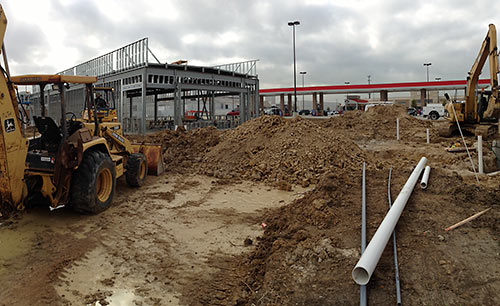
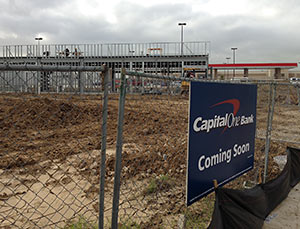 Reader Debnil Chowdhury sends in these pics, taken yesterday, of the steel-framed structure that’s appeared over the last month just north of the new Studemont Kroger gas station in the formerly industrial district just south of I-10 that Swamplot readers have dubbed ‘Katyville’ — in honor of the suburban-style developments rapidly going in there, a mere 2 miles northwest of Downtown. And these latest additions do appear to be pad-site-alicious: Directly north of the McDonald’s going up at 1510 Studemont St. (and pictured here), there’s a sign announcing a new Capital One Bank. There’s no indication yet whether the bank building will have a drive-thru as well, but the signs look good.
Reader Debnil Chowdhury sends in these pics, taken yesterday, of the steel-framed structure that’s appeared over the last month just north of the new Studemont Kroger gas station in the formerly industrial district just south of I-10 that Swamplot readers have dubbed ‘Katyville’ — in honor of the suburban-style developments rapidly going in there, a mere 2 miles northwest of Downtown. And these latest additions do appear to be pad-site-alicious: Directly north of the McDonald’s going up at 1510 Studemont St. (and pictured here), there’s a sign announcing a new Capital One Bank. There’s no indication yet whether the bank building will have a drive-thru as well, but the signs look good.
COMMENT OF THE DAY: HOUSTON, THE CITY OF LITTLE DOWNTOWN SUBURBIAS  “Why not have a ‘little suburbia’ in the area? I mean, let’s stop fighting it and sail [with] the wind.
Now I know I’m being a little tongue and cheek, but is there nothing more ‘Houston’ than to have a completely market driven transplant of the suburbs right next to downtown? We can even market it w/ such features as ‘the sidewalk to nowhere’ and the ‘stripmall, strip.’ Maybe even use it to advertise Houston to the rest of the country: “Close to work with suburban sprawl; yes, you CAN have it all!†Heck, we’ll just reboot the Virginia Slims campaign w/ big box stores and the skyline in the background!” [DNAguy, commenting on Texas City Buc-ee’s Opening Sooner Than Expected; The Rush To Destroy Rice’s Menil Legacy] Illustration: Lulu
“Why not have a ‘little suburbia’ in the area? I mean, let’s stop fighting it and sail [with] the wind.
Now I know I’m being a little tongue and cheek, but is there nothing more ‘Houston’ than to have a completely market driven transplant of the suburbs right next to downtown? We can even market it w/ such features as ‘the sidewalk to nowhere’ and the ‘stripmall, strip.’ Maybe even use it to advertise Houston to the rest of the country: “Close to work with suburban sprawl; yes, you CAN have it all!†Heck, we’ll just reboot the Virginia Slims campaign w/ big box stores and the skyline in the background!” [DNAguy, commenting on Texas City Buc-ee’s Opening Sooner Than Expected; The Rush To Destroy Rice’s Menil Legacy] Illustration: Lulu
From the self-described “guy with a quadcopter” behind Skyhawk Videos, here’s new aerial footage from high above the brand-spanking-new intersection of I-10 and Houston’s latest orbiting ringroad, the Grand Parkway. The view is primarily to the southeast, with a few tilts and glances in either direction; the new section of State Hwy. 99, aka the Grand Pkwy.’s Segment E, begins in the upper right of the initial image and extends to the lower left, across the Katy Prairie to the outlet mall in Cypress, running over an ancient burial ground in the process. The highway is carrying the last of its free traffic; tolls kicked in on Friday, about a month and a half after the segment opened and just a few days after Skyhawk’s drone shot.
In the lower right of the image is the new 151,600-sq.-ft. Katy Costco and gas station, scheduled to open to the public this Thursday. Its 14-acre site is the focus of its own separate video as well, filmed on January 25th:
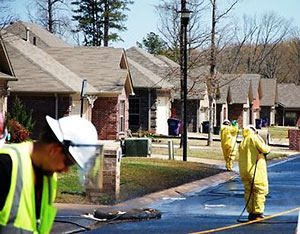 You know the old joke about suburban developments: That they’re typically named after the natural features that they replace. But in proudly announcing the name it has chosen for the new 692-acre residential development the company is planning near the yet-to-be-built northern segment of the Grand Parkway between I-45 and U.S. 59, Toll Brothers may have made that cliché seem quaint. According to the publicly traded homebuilder, which is working with Cernus Development on the project, the top selling point for this new community is its proximity to the new corporate campus ExxonMobil is building just 6 miles to the west. Northwoods will have room for 1,000 homes built by Toll Brothers and other builders, along with “resort-style amenities that take advantage of the mature trees and topography,” including trails, parks, lakes, and a recreation center.
You know the old joke about suburban developments: That they’re typically named after the natural features that they replace. But in proudly announcing the name it has chosen for the new 692-acre residential development the company is planning near the yet-to-be-built northern segment of the Grand Parkway between I-45 and U.S. 59, Toll Brothers may have made that cliché seem quaint. According to the publicly traded homebuilder, which is working with Cernus Development on the project, the top selling point for this new community is its proximity to the new corporate campus ExxonMobil is building just 6 miles to the west. Northwoods will have room for 1,000 homes built by Toll Brothers and other builders, along with “resort-style amenities that take advantage of the mature trees and topography,” including trails, parks, lakes, and a recreation center.
It’ll also have the same name as a 62-home subdivision in the Little Rock suburb of Mayflower, Arkansas, where an ExxonMobil pipeline accident last March resulted in the release of 210,000 gallons of diluted bitumen from the tar sands in Alberta, Canada, onto the streets and back yards of the middle-class neighborhood.
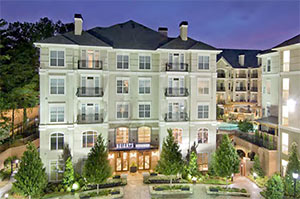 Hey, it worked for the River Oaks Cleaners and CityCentre! The latest, perhaps only half-unwitting entry into the ongoing Houston name-sprawl competition is “Heights at Park Row,” an apartment complex announced yesterday by an Atlanta developer but apparently already under construction in advance of an announced October opening date. The 342-unit rental compound, a mere 14 freeway miles west of the similarly named Houston neighborhood not known (yet) for its apartments, will hang back a tad from the southern freeway exposure of Wolff Companies’ this-and-that-use Central Park development, wedged ’twixt I-10 and
Hey, it worked for the River Oaks Cleaners and CityCentre! The latest, perhaps only half-unwitting entry into the ongoing Houston name-sprawl competition is “Heights at Park Row,” an apartment complex announced yesterday by an Atlanta developer but apparently already under construction in advance of an announced October opening date. The 342-unit rental compound, a mere 14 freeway miles west of the similarly named Houston neighborhood not known (yet) for its apartments, will hang back a tad from the southern freeway exposure of Wolff Companies’ this-and-that-use Central Park development, wedged ’twixt I-10 and a planned the recent extension of the Terry Hershey Park Bike Trail.
Central Park will, in fact, be entirely central to its own location, along Houston’s central concrete ribbon but only a little east of Hwy. 6:
How long will it take a Katy worker to zoom past acres of newly paved prairie, over a now-uprooted prehistoric burial ground, and under EZ Tag toll sensors on a lunchtime jaunt to the outlet mall in Cypress? Maybe as quickly as 5 minutes, if the 200mph speed reached last week by driver John Hennessey in one of his company’s souped-up Corvettes on the 15-mile stretch of the Grand Parkway between I-10 and Hwy. 290 can be maintained. Of course, that might become a little more difficult once the new Prairie Tollway opens to slower-moving traffic for the first time this coming Saturday.

